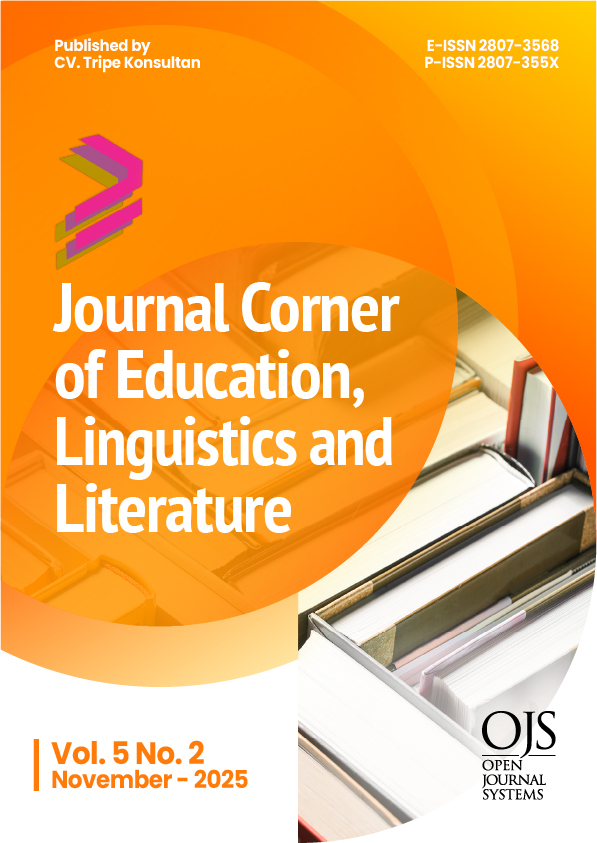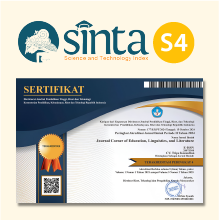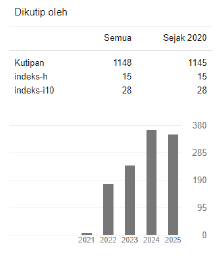Address Forms and Vocatives-Diminutives in Emily Brontë's Wuthering Heights
 https://doi.org/10.54012/jcell.v5i2.621
https://doi.org/10.54012/jcell.v5i2.621
 Abstract views: 240
Abstract views: 240
 PDF downloads: 100
PDF downloads: 100
Keywords:
vocative-diminutives, address forms, pragmatics, Wuthering Heights, Klaus P. Schneider, qualitative analysisAbstract
This present study is devoted to exploring the use of address forms and vocatives-diminutives in Wuthering Heights by Emily Brontë, with a focus on the way the use of language portrays the dynamic between the main characters and their emotions as well as their interpersonal relationships. With the help of a framework introduced by Klaus P. Schneider (2003) that captures diminutives as pragmatic speech act modifiers, the aim of the study is to identify specific types of vocative-diminutives and how they are used, with particular attention paid to Heathcliff, Catherine Earnshaw, and Edgar Linton's utterances. Through the use of a qualitative analysis method and library research, this study examines the chosen chapters of the novel by looking closely at the text and categorizing them according to their uses of diminutives in vocative, synthetic, and analytic forms. According to the results of the study, 27 diminutive forms are identified, and the most prevalent use of diminutives is the use of vocative full names, with seven instances. Following this, analytic vocative-diminutives are present six times, and synthetic vocative-diminutives could be found five times. In the meantime, vocative first names, vocative kinship terms, and vocative titles are all present twice, respectively. In addition, diminutive first names occur twice as well, whereas diminutive full names do not occur nearly as frequently, with only one instance.
Downloads
References
Abdullah, A. R., & Fitriansal. (2024). Address terms in English and Konjonese: A sociolinguistic study. Deiktis: Jurnal Pendidikan Bahasa dan Sastra, 4(2), 52–59. https://dmi-journals.org/deiktis/article/view/638/523
Almashour, M. (2024). Bridging worlds with words: Translanguaging and its impact on identity formation among Jordanian graduate students in Ontario. Frontiers in Education, 9, Article 1464741. https://doi.org/10.3389/feduc.2024.1464741
Asprey, E., & Tagg, C. (2019). The pragmatic use of vocatives in private one-to-one digital discourse [PDF]. Open Research Online. https://oro.open.ac.uk/61765/2/61765.pdf
Brontë, E. (1847). Wuthering Heights [E-book]. Project Gutenberg. https://www.gutenberg.org/ebooks/768
Bystrov, Y., Mintsys, E., & Mintsys, Y. (2021). English diminutives in children’s literature: A case study of directive speech acts. SKASE Journal of Theoretical Linguistics, 17(5), 77–96. www.skase.sk/Volumes/JTL47/pdf_doc/05.pdf
Creswell, J. W., & Creswell, J. D. (2018). Research design: Qualitative, quantitative, and mixed methods approaches (5th ed.). SAGE Publications.
Fabdriah & Zakrimal. (2017). The analysis of Heathcliff’s character in Wuthering Heights by Emily Brontë: A Sigmund Freud’s theory. Jurnal BASIS, 4(2), 29–42. https://ejournal.upbatam.ac.id/index.php/basis/article/view/529
Fionasari, R., & Saputra, E. (2024). Language and power: Analyzing discourse and communication dynamics in political and social contexts. Social Studies & Humanities Journal (SOSHUM), 1(1), 90–96.
George, M. W. (2008). The elements of library research: What every student needs to know. Princeton University Press.
Ho, V. (2023). Research on (Mandarin) Chinese. In X. Chen & D. D. Wu (Eds.), East Asian pragmatics: Commonalities and variations (pp. 105–117). Routledge. https://doi.org/10.4324/9781003053163-9
Holmes, J., & Stubbe, M. (2015). Power and politeness in the workplace: A sociolinguistic analysis of talk at work (2nd ed.). Routledge. https://doi.org/10.4324/9781315750231
Jassim, I. N., Ibrahim, H. M., Naeem, A. T., Saad, T., & Ali, A. (2023). A pragmatic analysis of bullying in Emily Brontë’s Wuthering Heights. Res Militaris, 13(1), 1681–1692. https://resmilitaris.net/uploads/paper/e9a9157a5876f5e69e4f6d26e69c94f9.pdf
Jumaa, A. D. O. (2019). Address forms and honorifics encoding in the Fur society. Advances in Social Sciences Research Journal, 6(8), 13–29. https://doi.org/10.14738/assrj.68.6668
Maché, J. (2025). The diversity of vocative formation across languages. Catalan Journal of Linguistics, 24(1). https://revistes.uab.cat/catjl/article/download/v24-n1-mache/475-pdf-en/2233
Maheswari, D., & Priyadharshini, A. (2024). Power and inequality in Emily Brontë’s Wuthering Heights. Shanlax International Journal of Arts, Science and Humanities, 11(S5), 1–5. https://doi.org/10.34293/sijash.v11iS5-Mar.7639
Mendoza, M. (2005). Polite diminutives in Spanish: A matter of size? In R. T. Lakoff & S. Ide (Eds.), Broadening the horizon of linguistic politeness (pp. 163–173). John Benjamins Publishing Company.
Mintsys, E. Ye. (2023). Vocative functions of diminutives in English prose literature for children. Folium, 1, 56–62. https://doi.org/10.32782/folium/2023.1.8
Mintsys, E., & Kulchytska, O. (2022). Diminutives in representative speech acts in English prose literature for children and young adolescents. International Humanitarian University Herald. Philology Series, 53(1), 120–123. https://doi.org/10.32841/2409-1154.2022.53-1.27
Ombati, J. M., & Onchieku, P. N. (2021). A morpho-pragmatic analysis of diminutives in Ekegusii language, Kisii, Kenya. International Journal on Studies in English Language and Literature (IJSELL), 9(6), 1–11. https://doi.org/10.20431/2347-3134.0906001
Oparnica, M., & Cerovski, N. P. (2022). The use of diminutives in everyday communication. Belgrade Linguistics Days (BeLiDa), 1, 327–345. https://doi.org/10.18485/belida.2022.1.ch13
Saeed, N. M. S., & Hussien, K. H. (2023). A pragmatic study of diminutives in Ahmad Shawqi’s plays. Manar Elsharq Journal for Literature and Language Studies, 1(3), 1–12. https://meijournals.com/ara/index.php/mejlls/index
Schneider, K. P. (2003). Diminutives in English (Linguistische Arbeiten, 479). Max Niemeyer Verlag.
Sodah, N. (2019). The impact of social status on language shift: A case study on family domain language in Lembar. International Journal of Multicultural and Multireligious Understanding, 6(3), 959–967. https://doi.org/10.18415/ijmmu.v6i3.891
Ullah, S., Ahsan, M., & Yousuf, M. (2024). Impacts of socio-economic factors on language shift: A case study of Siraiki L2 learners. International Research Journal of Management and Social Sciences, 5(1), 374–389. https://irjmss.com/index.php/irjmss/article/view/251
Downloads
Published
How to Cite
Issue
Section
License
Copyright (c) 2025 Veronika Esther Diah Kurniawati, Emanuel Sunarto

This work is licensed under a Creative Commons Attribution-ShareAlike 4.0 International License.
All articles published in the Journal Corner of Education, Linguistics, and Literature are licensed under the Creative Commons Attribution-ShareAlike License (CC BY-SA).

















